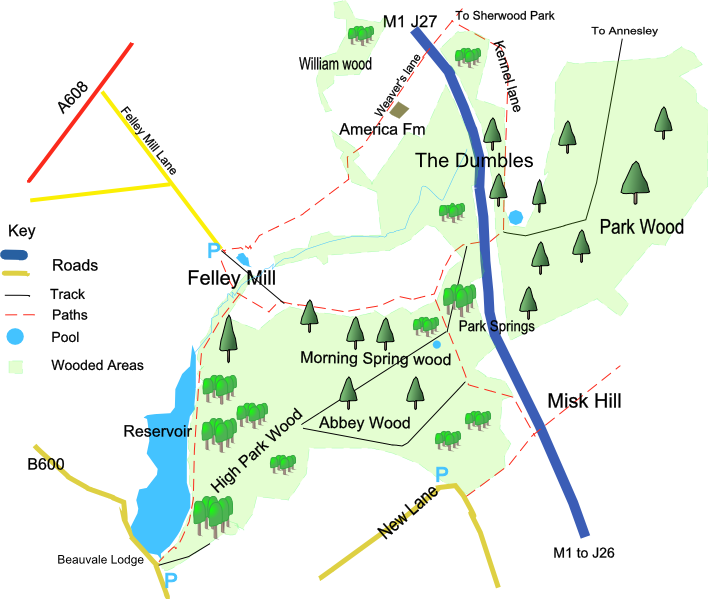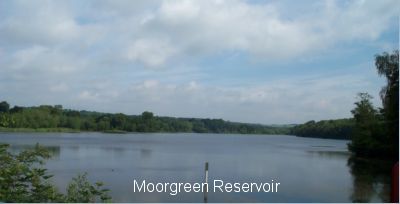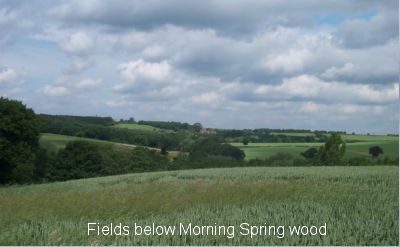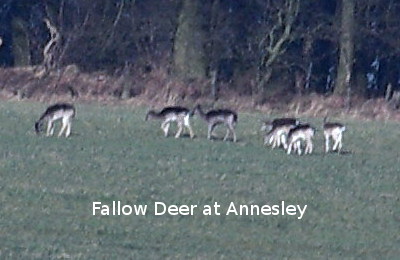Moorgreen, Annesley and Colliers Wood

This guide covers Moorgreen reservoir, the north part of Moorgreen, the south part of Annesley (this is the area on the map to the north east of Felley Mill and Colliers Wood (not shown on the above map.
History
The reservoir was built in around 1796, as a feeder water for the Nottingham canal. The local farms and houses have connections with D H Lawrence and Lord Byron.
Access
For car parking see the map. The parking by Beauvale Lodge consists of a layby, the parking by Felley Mill is at the side of the road and the parking on New Lane is a car park. Bus services along Wiley Lane include the Doyles/Dunn line 331. Eastwood to Mansfield buses go along the A608 and pass by Felley Mill Lane at the Sandhill Tavern. The standard of footpaths is very variable, the High Park wood and Felley mill track has recently been resurfaced, the wider forestry tracks are normally O/K, but the narrower ones can get muddy. There are some steep climbs towards America Farm from the south and in the Morning Spring area.
Habitats

The Reservoir is used for carp fishing. This is done from the shore and boats are not used. The usual species are present such as Coots, Mute Swans, Canada Geese and Little Grebes. In winter Pochard, Great crested Grebes, Ruddy Duck, Grey lag Geese and Tufted Duck are present with the Coots. There are no clear areas suitable for migrant waders, the woodland goes right to the edge of the water and there are few patches of reeds.
High Park Wood is a Oak and Beech wood, with honeysuckle, rhododendron, holly, elder and hawthorn as the understory. The Oaks are all of a similar age (being about 90 years old, probably planted after the first world war). There is a different and wider variety of trees at the Beauvale Lodge end, including Copper Beech (same species as the normal Beech but often grown for ornamental reasons, because of its leaf colour), and Horse Chestnut. It may have been an arboretum at one time. This is a private wood.
Felley Mill area is damper and has a lot of Alder. There is a stream running through it, which can contain Grey Wagtail. This is one of the better areas to see a wide range of species, with four species of Tit (Great, Blue, Long tailed and Coal), Nuthatches, Woodpeckers, Lesser Redpolls, Goldfinches and Thrushes being easy to see. If the area is quite (ie no dog walkers) then the pond (probably dug for the water mill) is worth a good explore.
Morning Springs Wood is mainly Scots Pine with a lot of Beech and some Oak. This is a Forestry Commission wood. Birds here include a higher percentage of Coal Tits than in the High Park Wood and a chance of Bramblings. Looking north and northwest from the track which runs at the side of the wood, gives excellent views over the dumble (Nottinghamshire’s name for a wooded valley) towards Felley Hall and Underwood. Common Buzzard is the most often seen raptor here with Kestrel being the runner up. Hobbys are occasional and Goshawks a remote possibility. Brambling can sometimes be seen in the winter, feeding on the Beech mast, in company with Chaffinches and Great Tits. It is also worth while to scan the fields to look for Fallow Deer, although they spend most of the daylight hours in the woods.
Abbey Wood Can't really think of anything to say about this area — boring maybe! Chaffinch and Coal Tits are a possibility. Called Abbey Wood because of the proximity of Beauvale Priory (maybe!).

The fields are mainly arable (wheat, oilseed rape or kale), with some set-aside. There are some horse paddocks in the area. Many of the fields are largish, but have either small copses or what could be remnants of the old hedgerows in them. Some of these are deformed — perhaps because of grazing by deer.
Birds
On the reservoir there are the usual species of ducks for Nottinghamshire such as Tufted Duck, Pochard and Ruddy Duck, plus Mute Swans and the inevitable Canada Geese, Coot and Little and Great crested Grebes. Also a few gulls, usually Black headed,loaf here in the winter.
Resident birds include Robin, Great spotted Woodpeckers, Lesser spotted Woodpeckers, Nuthatch, Tree Creepers, Coal Tits (especially in the Scots pine areas), Tawny Owl, Kestrel and Common Buzzard. Marsh Tits and Willow Tits are definitely uncommon.The Willow Tits are to be found in the Felley Mill area, and the Marsh Tits around the Beauvale Lodge area.
Summer visitors include Blackcap, Chiffchaffs, Willow Warblers and Spotted Flycatchers in the woodland with Common Whitethroats (on the farmland and hedges by the farm tracks).
In winter, Bramblings, Siskins, Redwings and Fieldfares appear. The Bramblings can be found feeding with Chaffinches and Great Tits under the Beech trees in the Morning Spring Wood area.
In June and July the High Park wood is a good area to see Treecreepers. The young have left the nest and sometimes a family party can be seen feeding in close proximity to one another. The tall mature woodland of the High Park Wood means lots of visible trunks. Look on the rougher bark trees such as the Oak and Scots Pine.
Lesser spotted Woodpeckers can be found in this wood, between the start of the tall trees on the eastern side and the point at which the public bridleway separates from the tarmaced road. As usual the best time is from February to May, when they are drumming, they are inconspicuous at other times. Here is a recording of their drumming(196KiBs).
Other Animals
 Fallow Deer are relatively easy to see here on the fields in the northern part of the map, especially in winter. These are a variety of colours including black which makes a contrast with the menil (pale) form found in deer parks. Their tracks can sometimes be seen in the mud by the streams and on the paths. Occasionally some can be seen wearing collars for tracking purposes.
Fallow Deer are relatively easy to see here on the fields in the northern part of the map, especially in winter. These are a variety of colours including black which makes a contrast with the menil (pale) form found in deer parks. Their tracks can sometimes be seen in the mud by the streams and on the paths. Occasionally some can be seen wearing collars for tracking purposes.
Colliers Wood
History
Part of the Greenwood Community Forest. It lies on the site of the old Moorgreen Colliery. The mine was first sunk in 1865 and was closed in 1985. In 1996 as part of the site renovation, some of the old colliery site was seeded with wild grasses and flowers. Hedgerows and thousands of trees were planted and two ponds plus drainage ditches were created.
Access
There is a tarmac surfaced car park and the paths are well surfaced and suitable for people of any age or ability. The site is open at all times.
Here is a map showing the location of Colliers Wood. There are signs inside the car park showing the paths and layout of the site. You can park here and walk to Moorgreen Reservoir, which is only 400/500 yards(metres) away. The two trails are called Barber Trail and Walker Trail, named after the Barber, Walker and Company which originally opened the mine.
Habitat
The largest pond just gives enough runway for a Mute Swan to take off. This has shallow edges and is ideal for amphibians and dragonfly larvae. The woodland, which consists of mainly Oak, Silver Birch and Alder is still young with the trees reaching a height of 10 feet or less. The grass is mown to various heights. The surrounding fields are all pasture with hedges. Drainage ditches have been dug which also give added attraction to wildlife, including hopefully Water Voles.
Birds
Wide variety because of the habitat, Mute Swans, Moorhens and Mallards on the pools, in winter Goldfinches, Greenfinches, Lesser Redpolls, Fieldfares and Redwings, Little Owls (nearby). In the summer, Skylark, Pied Wagtail, Willow Warbler and Common Whitethroat.
Updated 13th May 2010
Any criticisms, corrections or comments to the author Derek Huskisson

The text and photographs are licensed under a Creative Commons Attribution-Noncommercial-Share Alike 2.0 UK: England & Wales License.